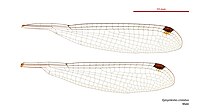Episynlestes cristatus
Appearance
| Tropical whitetip | |
|---|---|
| Scientific classification | |
| Domain: | Eukaryota |
| Kingdom: | Animalia |
| Phylum: | Arthropoda |
| Class: | Insecta |
| Order: | Odonata |
| Suborder: | Zygoptera |
| Family: | Synlestidae |
| Genus: | Episynlestes |
| Species: | E. cristatus
|
| Binomial name | |
| Episynlestes cristatus | |

| |
Episynlestes cristatus is a species of Australian damselfly in the family Synlestidae,[3] commonly known as a tropical whitetip.[4] It is endemic to north-eastern Queensland, where it inhabits streams in rainforest.[5]
Episynlestes cristatus is a large, very slender damselfly, coloured a dull bronze-black with white markings. It often perches with its wings outspread.[6]
Gallery
[edit]-
Female wings
-
Male wings
See also
[edit]References
[edit]Wikimedia Commons has media related to Episynlestes cristatus.
- ^ Dow, R.A. (2017). "Episynlestes cristatus". IUCN Red List of Threatened Species. 2017: e.T87537398A87540124. doi:10.2305/IUCN.UK.2017-1.RLTS.T87537398A87540124.en. Retrieved 19 November 2021.
- ^ Watson, J.A.L.; Moulds, M.S. (1977). "A second species of Episynlestes Kennedy (Odonata: Chlorolestidae) from north Queensland". Journal of the Australian Entomological Society. 16 (3): 257–259 [257]. doi:10.1111/j.1440-6055.1977.tb00097.x.
- ^ "Species Episynlestes cristatus Watson & Moulds, 1977". Australian Faunal Directory. Australian Biological Resources Study. 2012. Retrieved 15 April 2017.
- ^ Theischinger, Günther; Hawking, John (2006). The Complete Field Guide to Dragonflies of Australia. Collingwood, Victoria, Australia: CSIRO Publishing. p. 28. ISBN 978-0-64309-073-6.
- ^ Theischinger, Gunther; Endersby, Ian (2009). Identification Guide to the Australian Odonata (PDF). Department of Environment, Climate Change and Water NSW. p. 212. ISBN 978-1-74232-475-3.
- ^ Watson, J.A.L.; Theischinger, G.; Abbey, H.M. (1991). The Australian Dragonflies: A Guide to the Identification, Distributions and Habitats of Australian Odonata. Melbourne: CSIRO. ISBN 0643051368.



